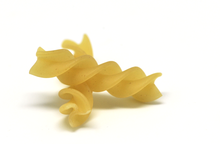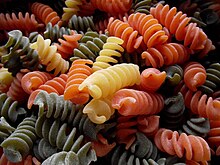Fusilli
Fusilli (from Italian fuso "spindle"), often called Spirelli or Spiralnudeln in German , are spiral noodles in the shape of a helix (helical) with a length of approx. 4 cm. They are made from durum wheat semolina , water and salt .
history
According to legend, the Fusilli are said to have been made around 1550 at the court of Cosimo I de 'Medici , the Duke of Florence : When one of the duke's cooks prepared pasta one day and part of it fell on the floor, it was said to be smaller Taking your son and wrapping it around your grandmother's knitting needle - the idea of the spiral noodle was born. Until well into the 20th century, the fusilli were mainly produced and sold by older women in the country.
variants
A distinction is usually made between the rotini (with a tighter and thicker spiral shape) and the larger Eliche (up to 7 cm in length) - names that have not become common in German usage. The Fusilli Bucati differ from the basic shape in that they are hollow in the middle.
use
Since cooked fusilli absorb sauces particularly well due to their spiral shape , they are preferably used. a. used for pasta salads .
See also
Web links
Individual evidence
- ↑ Vocabolario. fusillo. In: treccani.it. Treccani, la cultura italiana (Istituto della Enciclopedia Italiana), accessed on October 25, 2015 (Italian): “ fusillo s. m. [voce merid., dim. di fuso s. m.]. - Per lo più al plur., Fusilli , sorta di pasta fresca, all'uovo, che nel passato si otteneva arrotolando piccole strisce di sfoglia attorno a un ferro da calza a forma di spirale; oggi prodotta anche su scala industriale, meccanicamente, e senza uova, conserva la tipica forma elicoidale: un piatto di fusilli al sugo. "

